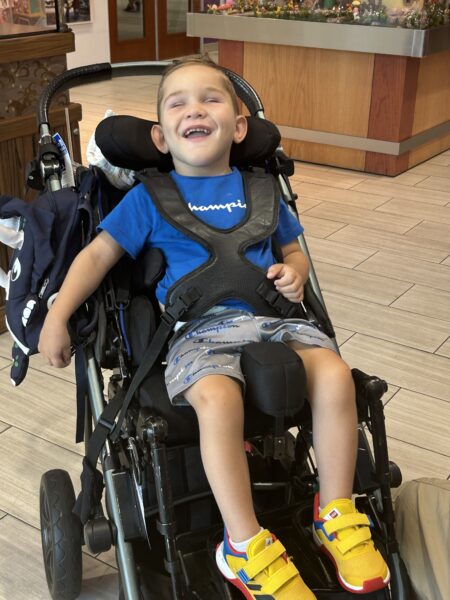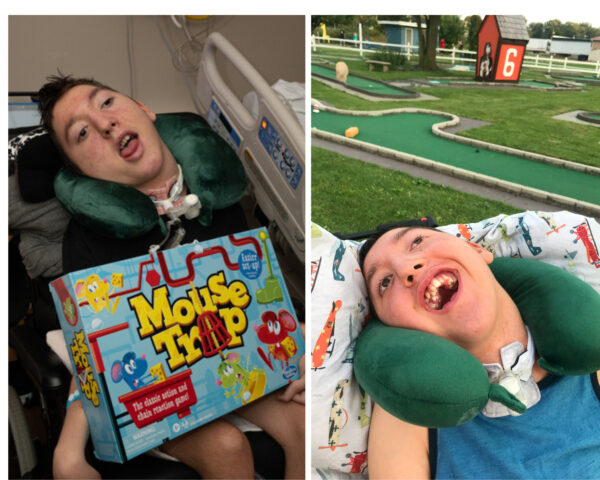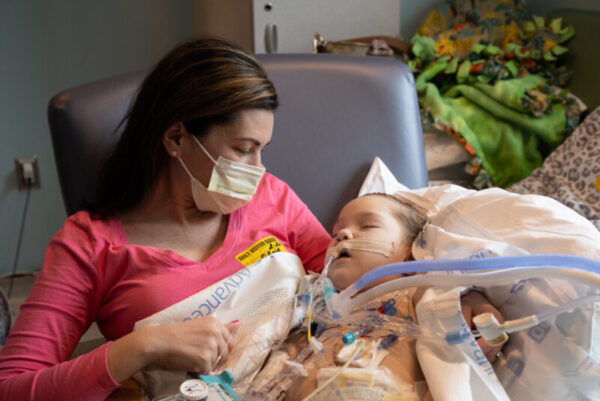
David Detwiler, age 4, fought and won a battle with sepsis this year. His mom says the quick intervention of his medical team likely saved his life.
Both Kyle Nottingham and David Detwiler are no strangers to Akron Children’s. Kyle, age 15, and David, age 4, have complex medical conditions that lead to frequent hospitalizations. Kyle has a neurologic condition known as Leukodystrophy hypomyelinating 6, which causes difficulty with muscle tone, spasticity, speech, body movement and eyesight. David, who is blind and was born with no functioning kidneys, has spastic quadriplegia, scoliosis and breathing issues. He underwent a kidney transplant in 2021.
While the boys have different medical conditions, one thing they have in common is they both fought and won a battle with sepsis this year. Sepsis, or blood poisoning, is the body’s extreme response to an infection. It is considered a life-threatening medical emergency if left untreated.
According to Amy McHenry, lead APP in pediatric intensive care, sepsis starts a chain reaction throughout the body and any infection can lead to it. In 2019, Akron Children’s joined the Children’s Hospital Association’s national collaborative, called Improving Pediatric Sepsis Outcomes (IPSO), to share best practices and information allowing its member hospitals to create the needed processes to recognize sepsis and initiate timely care.
Part of that care has been following a standardized process called a sepsis bundle that includes early identification (with a trigger tool), sepsis huddle (at the bedside with a nurse, provider, resident and physician), use of a sepsis order set, and timely administration of fluids (within 30 min.) and antibiotics (60 min.).
“If this bundle is followed, sepsis mortality decreases by almost 50% and hospital length of stay by 25%,” said Amy.

Kyle Nottingham, age 15, also fought a battle with sepsis this year. Kyle is recovered and back to enjoying playing baseball with his Canton Challenger team as well as participating in Akron Children’s Dance Unlimited program.
Amy says the work of the hospital’s sepsis subcommittee has helped improve education and awareness about sepsis hospital wide.
“We provide annual education for providers and staff nurses on the sepsis bundle, fluid bolus administration and the huddle process,” she said. “Standardized signs in all patient rooms and staff areas also help increase awareness about sepsis. Our theme is ‘suspect sepsis, save lives.’”
In David’s case, his mom, Carlla, was the one to sound the alarm that something wasn’t right.
“David had recently had surgery to have his tonsils removed and I noticed he wasn’t breathing right,” she said. “He was complaining his head was hurting. He just wasn’t acting like himself.”
Carlla alerted Dr. James Besunder, pediatric intensivist, who immediately suspected sepsis.
“He put David on a broad spectrum antibiotic while we awaited the results of his blood cultures,” said Carlla. “This was by far the scariest hospitalization we have ever been through.”
Similarly, Kyle was hospitalized this summer and began showing signs of increased agitation and abdominal distension. His mom, Jenny, noticed he wasn’t acting right and says she later learned his sepsis was likely the result of a bowel blockage.

During David’s hospitalization, Carlla was grateful to be able to hold him as part of the PICU’s MOVE IT! program. The program improves parental satisfaction with their child’s treatment because they’re able to be more hands-on and hold and hug their child while intubated.
“Kyle was not in the PICU so the team on his floor did a great job triggering the early warning system and following the sepsis bundle and protocols,” said Amy. “He started on antibiotics and fluids and underwent surgery to clear up the blockage.”
After completing his antibiotics, Kyle was discharged home and is now enjoying his freshman year at Washington High School in Massillon and returning to playing baseball through the Canton Challenger program.
David continues to have some health challenges, but Carlla says he wouldn’t be alive if it weren’t for Dr. Besunder’s quick intervention.
“We still talk about it,” she said. “I’m so grateful and thankful that David is still with us.”
What causes sepsis?
- Sepsis happens when an infection of the skin, lungs, gastrointestinal or urinary tract or somewhere else starts a chain response throughout the body.
- Any person can get an infection, and almost any infection can lead to sepsis.
- Children with a lowered immune system are at higher risk of getting sepsis.
Early warning signs of sepsis
Alert your child’s doctor if he/she has any of these:
- Fever
- Nausea or vomiting
- Difficulty breathing
- Decreased urine output
- Mental decline
- Rapid heartbeat
- Low blood pressure
To read more inspiring stories about patients who have recovered from sepsis, visit our blog and use the search word sepsis.










